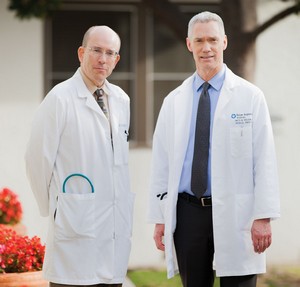Physicians’ Perspective on the Passy Muir® Speaking Valve
David R. Nelson, MD, Medical Director, Barlow Respiratory Hospital
Scott A. Sasse, MD, Pulmonary Medical Director, Barlow Respiratory Hospital
Barlow Respiratory Hospital is a unique place to practice medicine. The hospital is small, only 60 beds on the main campus in Los Angeles. The hospital was founded in 1902 as a Tuberculosis Sanatorium and remains surrounded by nature, despite its location only a few miles from downtown. At Barlow Respiratory Hospital, our interdisciplinary staff is tight-knit and works as a team. Our patients are primarily transferred to us from intensive care units at other facilities in the surrounding area. We have developed an effective methodology for in-line use of the Passy Muir® Valve with mechanically ventilated patients.
From our point of view, the Passy Muir Valve offers patients a feeling that they can control their destiny. It gives the patient a sense of well-being, an ability to participate in their medical care, and restores a sense of independence.
Physiologically, in the appropriate patient, the valve improves the ability to cough and clear the airways. It reduces the chance of aspiration and provides protection by decreasing the chance of bacteria lingering above the tracheostomy.
Equally important is the psychological impact of being able to communicate. Patients on mechanical ventilators find it very difficult to communicate. They try to write, use gestures, or mouth words. Limited options for communication lead to a great deal of frustration. All of that just goes away when they can talk – when they have a voice. When the Passy Muir Valve is inserted for early intervention and use with mechanical ventilation, it makes the patient happy, and it makes the family more content. In some cases, we can insert the valve into the circuitry of the mechanical ventilation in the morning, and that very same day, the patient can pick up the phone and talk to a family member who has not heard their voice for weeks, sometimes even months.
Each of us has seen the benefit of the Passy Muir Valve. Being able to communicate needs and feelings is very beneficial. It provides patients with a different perception of their physicians. Physicians are seen as helpful to their healing process. Typically, when patients see a physician coming, they sometimes cringe, expecting something that is going to hurt – another needle or another tube. But with the Passy Muir Valve, we are able to offer our patients something of medical value that also is painless and has the benefit of lifting their spirits.
Communication is not only good for our patients, it is also good for us, as physicians. Patients can tell us what is going on with them.
Both of us have a great deal of experience with using the valve and seeing its benefits. Each of us also has seen the benefit of the more aggressive use of the Passy Muir® Valve through early intervention with patients who are mechanically ventilated. For many, many years, we had used the Passy Muir Valve when a patient was close to finalizing the weaning process or was completely off the ventilator. In the past year and half, we have made a change in our approach to when we introduce the speaking valve.
Now, it is in our protocol to try the patient on the valve much earlier, while still on the ventilator. We are very fortunate that our team includes exceptionally experienced Respiratory Therapists and Speech Therapists. They are proactive in identifying patients who are good candidates for early introduction of the valve. Overall, both of us are convinced of the positive physiological and psychological impact of the Passy Muir Valve for our patients.
Recently, we had a patient who had been on the ventilator for a few weeks. At the previous hospital, they had not tried to wean her. We inserted the valve soon after she settled in, and she was delighted. It is a joy to see the difference this makes for our patients. We see the Passy Muir Valve as an opportunity to embrace excellence in our medical practice while reclaiming a small measure of enjoyment for our patients.
This article is from Volume 6 Issue 1 of Talk Muir Fall 2016. Click here to view Physicians’ Perspective on the Passy Muir® Speaking Valve.











